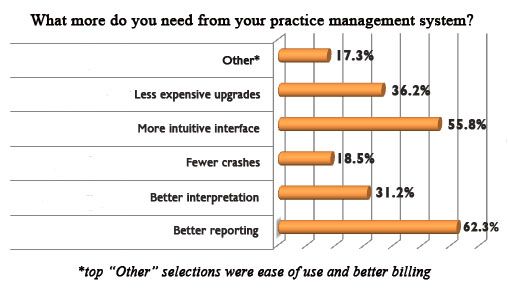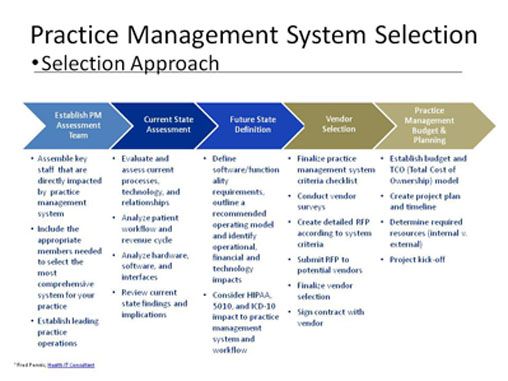2010 Tech Survey: Selecting the Right Practice Management System
Just like a Swiss Army knife, your practice management system should do everything you need it to do in one central location to guarantee your office’s survival. However, much like the valued outdoor utility tool, there are so many different options in terms of tools, gadgets, and styles that choosing the right one can be difficult.
Note: This is the third in a series of blog entries delving into the results of our 2010 Physicians Practice Technology Survey. Full results are now available at www.physicianspractice.com/technology-survey.
Just like a Swiss Army knife, your practice management system should do everything you need it to do in one central location to guarantee your office’s survival. However, much like the valued outdoor utility tool, there are so many different options in terms of tools, gadgets, and styles that choosing the right one can be difficult.
As part of the 2010 Physicians Practice Technology Survey, we asked respondents about their systems and 54 percent said what they are currently using is not living up to expectations. When pressed for more detail on what they sought, given multiple options, better reporting (62 percent) and more intuitive interface (55.8 percent) topped respondent’s wish list.

Even the AMA and Medical Group Management Association are noting the challenge of choosing the right practice management system amid new “meaningful use” guidelines for EHRs. The result is many practices either buying a whole new system or upgrading their existing technology to gain access to federal incentives through their EHRs.
The two organizations have partnered on a new online resource, offering member practices access to guidance in selecting the right system for their needs. The “Selecting a Practice Management System” toolkit offers a step-by-step guide and checklist to help practices find products and later this year, the AMA and MGMA say they plan to add an online directory of software vendors.
PENNIC’S PLAN
So how can you find the right system for your office? We have a plan for you.
Fred Pennic, a healthcare IT consultant who also blogs about technology, says after defining how much you want to spend on a system, there is a five-phase approach to matching your practice with the right tool, whether it is your first system or time for a change.
First is getting the right people to the decision-making table by establishing a steering committee or assessment team to make sure each component of your office is represented.
“Practices need to do their due diligence in researching and understanding what it is exactly they want,” said Pennic, who has six years of assessment, consulting, and implementation experience in managing multiple vendor systems. “You need to have the foresight and vision to get there first and have the proper people involved. If you don’t, [the system] is going to impact their everyday work flow and if it doesn’t work for them, it becomes a huge hurdle.”
The next phases of Pennic’s plan involve assessing your current practice as well as where you think it will be headed in the future, not only in terms of how your office runs, but also changes in the healthcare industry. For example, Pennic notes that with ICD-10 and version 5010 electronic administrative transactions looming around the corner, see how your potential vendor partners are preparing for the future.
“You need to be sure vendors have an upgrade plan and, first, if they are even ready for 5010,” he said. “Ask them what kind of plan they have because a lot of smaller vendors I have talked to haven’t started planning and that is something to think about.”
Other current and future considerations include determining if you are better off with a subscription-based model, whether you’ll house your server or have it off-site, and - if you have an IT staff - what their role will be in your practice management system.
Click on the image for a larger version.
“There are so many things to consider,” Pennic said. “But it is about identifying the positives of what you have now and what you want to keep in place with your work flow. It is also about identifying any gaps or other issues that are going to definitely hinder you from getting to your next steps [with your practice] and how to overcome that.”
SURVEY THE FIELD
When it comes time to select a vendor, Pennic says you should consider a vendor survey before narrowing the field to just one or two companies for your RFP.
“In my opinion, they [the vendors] should be fighting for your business and you definitely don’t want to go to just one or two - you are already narrowing down your search,” he said. “So if you cast a larger net and are able to narrow that down…you can help find the right vendor that is going to help you get to the next level.”
Plus, Pennic adds, don’t be afraid to get a feel for the company you are possibly partnering with. Remember, this is a long-term investment. In fact, the majority of our survey respondents - 34 percent -indicated that they bought their current system between one and four years ago, followed closely by 33 percent who purchased their system more than four years ago, but less than a decade ago.
“Ask if they have a strong financial history and if they are ‘going away’ in five years, because you are relying on them to be there with you,” he said. “You need to be sure they will be around for years to come and not a here today, gone tomorrow type of vendor. Since the [HITECH Act] was signed, everybody is trying to make money and get involved in the game right now because it is hot right now.”
When narrowing down the field, Pennic also advises asking for a list of references to see how other physicians practices are using the system and can speak to its pros and cons.
“No physicians practice is exactly the same, but sometimes there are a lot of similarities and just being able to talk with somebody who has been through the process, you can definitely use as a base model to help – especially if you are doing this for the first time,” he said. “You can take those lessons learned from that reference client, build upon those, and move forward to being more successful than they are.”
Just as there is no “one-size-fits-all” model for practices, the same is true for practice management systems, Pennic says. Unless it is custom-made for your office only - an expense few practices can afford - you will still find room for improvement in your choice, just as our survey respondents did.
“If you can get 75 percent of what you want, then that’s good,” he said. “But there will always be room for improvement. As far as having everything you want, I’ve never known anything where it is going to be 100 percent. It is not going to happen.”
But Pennic’s advice to those who took our survey and see shortcomings in their current system: Let your vendor know.
“This is a partnership, so they have to know those issues,” he said. “You have to make those demands and hopefully they are working on it and the system improves. Or it comes to a point where you find you can’t use the system anymore and it is outdated, so you have to purchase a whole new one and that is another big expense.”
Ep. 52: Private equity and hospital consolidation with Yashaswini Singh, PhD, MPH
February 17th 2025Yashaswini Singh, PhD, MPH, a health care economist and assistant professor at Brown University's School of Public Health, discusses her recent research article on private equity and hospital consolidation in primary care.
